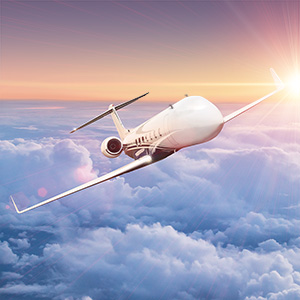
Sensing technology, computing, and artificial intelligence (AI) are revolutionizing the skies. In recent years, the military has been applying drone technology to pave the way for the pilotless fighter jet. In 2013, the U.S. Navy landed a fighter-size, computer-guided drone on an aircraft carrier; while in 2014, the U.K.’s Ministry of Defense and BAE Systems announced that a pilotless stealth fighter had passed its first-ever test flights.

Idea of Commercial Pilotless Jets Takes Flight
Now, attention is turning to the commercial sector, as a recent report from Swiss bank, UBS, claims that pilotless planes could save the aviation industry $35 billion a year. Boeing recently completed a test flight of an autonomous passenger aircraft prototype, which may reduce gridlock on our highways by shifting commuting to the skies. Designed as an air taxi, the Passenger Air Vehicle is capable of vertical take-off and hovering. Rival Airbus is developing Project Vahana, a self-piloted passenger aircraft also capable of vertical take-off and landing.
Meanwhile, the BAE Systems has successfully flown a converted JetStream 31, capable of carrying 16 passengers, 300 miles from Lancashire to Inverness. Human pilots assist with take-off and landing, but switch to robotic mode for the flight. The plane uses a cockpit-mounted infrared camera, a network of seven other cameras on the underside of the aircraft, and a collision avoidance system. A team of ground-based engineers monitor and communicate as needed via satellite and radio controls from a mobile control station.
From Autopilot to No-Pilot — Not a Big Leap
Proponents of pilotless passenger jets point out that planes already use autopilot, onboard computers, and fly-by-wire technology (which uses computers to process flight-control inputs from human and autopilots) while landing. Currently, human pilots reprogram the autopilot to adjust the flight path for weather or traffic – something that may be handled by AI in the future. However, there are big challenges ahead.
Security is a huge concern – pilotless commercial airliners could be a hacker’s paradise. And can artificial intelligence ever make up for the human kind? What would an AI pilot do when faced with a passenger having a heart attack mid-flight or a “Sully”-type situation? (Captain C.B. Sullenberger successfully guided US Airways flight 1549 to an emergency landing on the Hudson River after the plane struck a flock of Canadian geese, which disabled the engines).
Flying the Friendly Skies — Without a Pilot?
Although the UBS report stated potentially huge savings in moving to pilotless planes, their survey of 8,000 people revealed that only 17 percent said they would undertake a pilotless flight. More than half said that they would refuse, even if fares were cut. For that reason, it is more likely that cargo flights will implement pilotless technology first, with passenger flights cutting the number of pilots from two to one in the cockpit, with one remotely located on the ground as a first step. For pilotless flights to truly take off, overcoming human resistance is perhaps the biggest challenge of all.

Read other articles in this series:
- Silicon Snack: Technology in Medicine Is Just What the Doctor Ordered
- Silicon Snack: eSports Are Taking the Field
- Silicon Snack: AR/VR Changing How We Learn
- Silicon Snack: Precision Farming Fueled by Big Data
- Silicon Snack: Brushing Up on Art Restoration
- Silicon Snack: New World of Possibilities Delivered with Drones
- Silicon Snack: On the Ball with Sports Tech
- Silicon Snack: Robots Get Social
- Silicon Snack: Stepping Out with Smart Shoes
- Silicon Snack: Food Preparation – Taste the Future
Editorial Note: The use of any company, product, or trade names is for descriptive purposes only and does not imply endorsement by Lam Research Corp. or its subsidiaries.